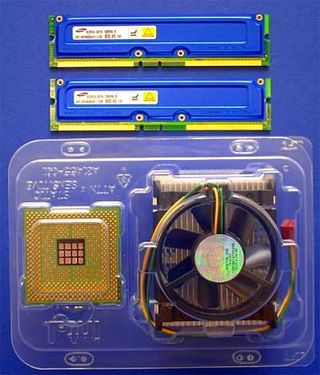A New Lease On Life - How To Make Your PC 5 Times Faster
FSB Clock Speed - 100 Or 133 MHz
Since the Abit BX6 comes furnished with the Intel 440BX chipset, the board only officially supports a maximum front side bus clock speed of 100 MHz. For all other speeds that exceed the 100 MHz limit, the AGP bus and possibly other devices are being run above their specified limits. When used in conjunction with certain graphics cards, this can result in instability. During the week-long testing phase we still didn't register any anomalies. Aided by the Socket adapter, the Pentium III/800 fulfilled its duties with nary a whimper. The effect installing a new processor had on the performance can be seen in the benchmark results in this article. The Abit BX6 had a high performance at an FSB clock speed of 133 MHz.
The Newcomer Pentium 4 - A Sinfully Expensive Upgrade
If you want to build your entire system around an Intel platform, you could also consider purchasing a Pentium 4 system. Ignoring the fact that, in addition to the CPU itself and the accompanying RDRAM, the motherboard has to be replaced as well, the newcomer Pentium 4 could also be a choice. However, a closer examination of price lists, with costs soaring over $800, has this dream deferred drying up like a raisin in the sun. Be that as it may, there exists a clientele that only trusts Intel technology, particularly in the business sector. On the other hand, there are also users who would never dream of purchasing a Pentium 4. However, these decisions are always a reflection of each user's political affiliation.
When upgrading to a Pentium 4, it is important to remember that a Socket 423 motherboard requires an additional voltage jump from the power supply. This is provided by an ATX-12V connection, which isn't part of our old power supply. Available for a few bucks in computer supply stores, an adapter can remedy this problem. In order to include the most expensive upgrade in our comparison, we installed a Pentium 4/1500 with its motherboard (Gigabyte GA-8TX) and 256 MB RDRAM in our old case and ran tests on it. One thing is already clear - the cost of totally revamping the system like this are much too high and aren't worth it. We could have just as well installed a new board with a Socket 462 and AMD Athlon processor - it would have been considerably less expensive. This example is only intended to demonstrate how the most recent Intel platform, consisting of the board with the 850 chipset combined with the Pentium 4/1500 and 256 MB RAM, behaves in different benchmark disciplines.

The Pentium 4/1500 bundled (boxed version) with 256 MB Rambus memory, CPU fan and thermal paste.
Stay on the Cutting Edge
Join the experts who read Tom's Hardware for the inside track on enthusiast PC tech news — and have for over 25 years. We'll send breaking news and in-depth reviews of CPUs, GPUs, AI, maker hardware and more straight to your inbox.
Current page: FSB Clock Speed - 100 Or 133 MHz
Prev Page Slot Adapter: New CPU In An Old Board Next Page Memory Clock Speed - 66, 100, 133, Or 400 MHz?Most Popular

